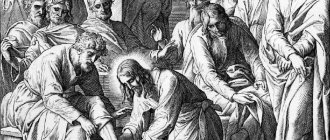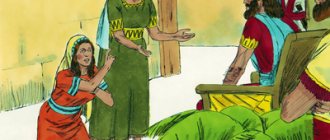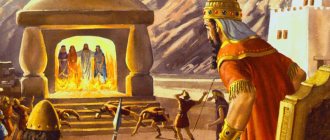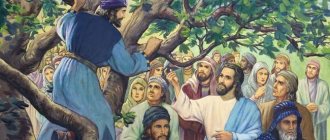Author and time of writing.
From the first verse of the first chapter of this book it follows that it was written by Joel, the son of Bethuel. His name means "Jehovah is God." Unlike other prophetic books, this book does not contain any indications of the time of Joel's prophetic ministry. It does not contain any information about the personality of the prophet. Theologians who have studied the Book of the Prophet Joel over the centuries offer three options for when this book could have been written.
1. The book was written in the early pre-war period. Namely, in the 9th century BC. Those who hold this point of view refer, in particular, to its place in the Jewish Old Testament writings - between the books of Hosea and Amos. And also to the mention of Tire, Sidon, Philistia, Egypt and Edom - the enemies of Israel in ancient times (Joel 3: 4,19), instead of such later enemies of Israel as Assyria, Babylon and Persia.
However, both of the arguments presented are not strong enough. Let's start with the fact that the position of the Book of the Prophet Joel in the Jewish canon is conditional. The authors of the Septuagint place it in a different place. Further. It is known that those prophets who lived during the Babylonian period uttered prophecies against the “early enemies” of the Jews (the peoples listed above); Jer. 46-47; 49:7-22; Ezek. 27:30; Soph. 2:4-7. In developing this thought, we note that those who are inclined to a later pre-exile date for the appearance of the book (the second point of view) could object to the following: in the second chapter, the Babylonians are presented so vividly and in such transparent images for the Jews of that time that in the formal clarification of that , about whom the prophet is speaking, they had no need.
Supporters of the early date of the book's appearance (in the middle of the 9th century BC) pay attention to the type of government that is supposedly reflected in it. There is no mention of a king or kings, but the elders and priests are “present” as persons apparently exercising the functions of government (1:2; 2:16; 1:9,13; 2:17). In this regard, there is an assumption that the book was written after the reign of the seven-year-old Joash (reign: 878-838 BC), who, as is known, was led by the pious high priest Jehoiada (2 Kings 11-12).
In support of this assumption, they also refer to the author’s silence regarding the eternal problem of idolatry in Israel. But these assumptions do not sound convincing enough to make a categorical conclusion about the early time of the book’s writing. In turn, serious arguments are also made against the early date. For example, it is difficult to reconcile with her what is said in 3:2,6.
2. The book was written in late pre-war times. This opinion seems convincing in many respects. A number of "difficult passages" are consistent with the writing of the prophecy between 597 and 587. Thus, what is said in 3:26 regarding the “dispersion of Israel” and the “division of the land of God” is correlated with the Babylonian invasion of 597, when 10 thousand of the best people of Judah were deported from the country (2 Kings 24:10-16). This date does not contradict Joel’s references to the temple (1:9,13; 2:17), because it was destroyed only in 586 BC (2 Kings 25:9). The supposed date then says that in Joel. 1:5 and 2:1-11 contain anticipation of the final destruction of Jerusalem, which took place in the year 586 (2 Kings 25:1-21).
Also in this case, Joel's prophecy is consistent with the proclamation of the “day of the Lord,” or “day of God’s wrath” (compare Lamentations 1:12; 2:1,21-22; Ezek. 7:19; 13:5; Zeph. 2 :2-3). What Joel describes in 2:1-11 coincides with what the prophet Jeremiah says about the Babylonians (Jer. 5:17). Link in Joel. 3:6 on the slave trade between the Phoenicians and the Greeks (Ionians) is understandable in light of the writing of this book in the late pre-exilic period. We find a similar reference in Ezekiel (Ezekiel 27:13).
The opinion that places the Book of the Prophet Joel at a later pre-exilic date is convincing in many respects, but not in all. Thus, those who share this opinion face a difficult problem in interpreting Joel. 2:18-19. These verses seem to speak of the outpouring of God's mercy on Joel's contemporaries (due, apparently, to their sincere repentance; see commentary on these verses). But if this is so, how can this be reconciled with the historical events of the last days of Judah? After all, even the spiritual “revival” of Judea during the reign of the pious King Josiah (640-610 BC) did not persuade the Lord to mitigate the punishment of this sinful people (2 Kings 23:26-27).
3. The book was written in the post-exile period. Those who share this opinion believe that:
1) In Joel. 3:1-2,17 implies the destruction of Jerusalem and the exile of the Jews to Babylon. The temple referred to in 1:9,13; 2:17, is, in their opinion, the second temple, the construction of which was completed by the Jews returning from Babylon in 515 BC.
2) The “elders” mentioned in 1:2 and 2:16 are the leaders of the community (“rulers”). What is said about them, and not about the “king,” is more characteristic of the post-exile period (compare with Ezra 10:14).
3) Joel quotes other prophets, including Ezekiel (compare Joel 2:3 with Ezek 36:35; Joel 2:10 with Ezek 32:7; Joel 2:27-28 with Ezek 39:28-29 ).
4) The reference to the Greek slave trade is still more consistent with the post-exile period.
Here are four counterarguments that could be given to each of the four above provisions.
1) In Joel. 3:1-2.17 could also mean the deportation of the Jews in 597 (not necessarily in 586) BC. But we have to admit that with this “approach” its own problems arise (this is mentioned above).
2) The absence of any mention of “kings” may be surprising and puzzling, but the “argument of silence” in itself is not a strong argument. In this regard, it should also be noted that the elders, or elders, were prominent figures in the Jewish community even in pre-exilic times (2 Kings 23:1; Jer. 26:17; Lamentations 5:12,14).
3) As noted above, the issue of “literary parallels” in the prophetic writings is difficult to resolve, since it is often not easy to determine where we are dealing with the original and where with borrowing.
4) It was said above that the Ionians (Greeks) traded slaves before, back from the 7th century BC.
Thus, it is impossible to say unambiguously in which of these three time periods the Book of the Prophet Joel was written.
Peculiarities of interpretation of the Book of the Prophet Joel.
1. What army is meant in 2:11? Some people think that it is the plague of locusts that Joel is talking about. 1, but that in 2:1-11 an even more terrible “defeat” of all plant life is allegorically described. Several arguments are given in favor of this opinion. Here they are:
1) There are clear literary parallels between chapters 1 and 2 (compare 2:2,11 with 1:6 and 2:3 with 1:19). 2) Several "details" in 2:1-11 favor literal locusts, namely: the myriad of attackers (2:2,5), the nature of the devastation they cause (2:3), their ability to "leap" and "climb" on high" (2:5,7), "to darken" the sky like clouds (2:10). 3) Verse 11 (“His hordes”) and verse 25 (“My great army,” identified with locusts, etc.) in chapter 2 seem to be directly associated with each other. 4) All this “army” or “horde” has in 2:4-5.7 the features of a literal army. Their likening to each other (constant comparisons: His appearance as a kind of horses... as horsemen... as if with the sound of chariots... as a strong people... in battle, as fighters... and as brave warriors) precisely testifies against the “real army” in this context , since the enemies who invaded the land are compared to a real army.
In the light of what has been said, the following interpretation seems most likely: the description of the disaster in chapter 2 is clothed in images of that other disaster, which is presented in chapter 1. The prophet really foresees the invasion of the land of Israel by enemy hordes and likens them to hordes of locusts. The latter are for him not only an image (which in Joel merges with what is depicted), but also a herald of the terrible day of the Lord.
Thus, in chapters 1 and 2, the interconnection and continuity of the “courts of the Lord” arises; their merciless nature is emphasized through images and allegories. The “judgment” described in the 1st chapter has taken place, and the one described in the 2nd chapter is coming: hordes of locusts have fallen on the earth, and new hordes of “locusts” will fall on it! Let us present several considerations in support of this reading of the text of the first 2 chapters of the book. 1) The “army” described in 2:1-11,20 is called “coming from the north.”
Typically, swarms of locusts invade Palestine from the south or southeast, rather than from the north (although they occasionally swarm from the north or northeast). So “coming from the north” most likely refers to a “real” foreign army, especially since the historical invasions of Palestine, or those that theologians identify with eschatological events, are most often described in the Bible as “coming from the north.”
This refers to the invasions of Palestine by the Assyrians (Isa. 14:25,31), the Babylonians (Jer. 6:1,22; 15:12; Ezek. 26:7), as well as the armies of Gog (Ezek. 38:15). 2) In principle, in the ancient East the allegory of locusts “was in circulation” in relation to enemy armies, and this speaks in favor of the likelihood of its use by Joel in chapter 2. 3) In God’s curses recorded in chapter 28 of the book of Deuteronomy, the “invasion” of locusts (Deut. 28:38-39) and the invasion of hostile armies (Deut. 28:25,32-33,49-51) are “consonant” with each other.
Indeed, in both cases, the “fruits of the earth” that fed its inhabitants perished (Deut. 28:33,51 compare with Is. 1:7; Jer. 5:17). A similar association arises when comparing Joel. 1:9 with Joel. 2:3. Let us present evidence from antiquity, which is contained in the Assyrian cuneiform monument (722-705 BC). This is how it describes the consequences of the Assyrian invasion:
“The city of Anyashtaniya... together with 17 cities adjacent to it, I (Sargon) destroyed and razed to the ground; I set the cities and the harvest of the fields and the fields themselves on fire. Their granaries, full of grain, I opened for my warriors, and all their countless reserves were destroyed. I released the animals from my military camps, like locusts, into their meadows, and they devoured all the vegetation around, without which the named cities cannot exist; the plain on which they stood became a desert."
Therefore, 2:1-11 probably refers to some actual army coming from the north, which is described in the form of all-consuming locusts, in order to emphasize that, like the locusts, they will be an instrument of God's wrath.
2. “The Day of the Lord” in the Book of the Prophet Joel. The description of the “day of the Lord” is undoubtedly influenced by the traditional concept of God's intervention in the wars that Israel initially waged. But although this is true, the very expression “day of the Lord” is generated by the belief or conviction that existed in the ancient East that a king, truly powerful, was able to begin and victoriously complete an entire military campaign in one day.
Thus the expression "day of the Lord" is essentially an idiom emphasizing the swift and decisive nature of the Lord's victory over His enemies in all circumstances. In the Old Testament, this expression can refer either to a specific historical event or to the battle of the end of times (i.e., have an eschatological character) with which this age will end. Let us list the ideas and phenomena associated with the “day of the Lord”: 1) Sometimes this concept implied the judgment of God’s people, whether over the Northern kingdom at the hands of the Assyrians (Amos 5:18,20), or over the Southern kingdom through the Babylonians (Lam. 1 :12; 2:1,21-22; Ezekiel 7:19; 13:5; Zeph. 2:2-3).
Sometimes this judgment was depicted in the context of a general judgment of the nations (Isa. 2:12; Zeph. 1:18). 2) The concept of the “day of the Lord” is often associated with judgments against pagan nations. This could be their “mutual judgments” against each other (according to the will of God): the Medes “punish” the Babylonians (Isa. 13:6,9), the Babylonians punish the Egyptians (Jer. 46:10; Ezek. 30:3); but there can also be judgments, as if directly carried out by the Lord, without reference to “earthly instruments” (about the judgment of Edom in Is. 34:8-9). The eschatological invasion of the coalition of northern peoples is clothed in the same concept (Ezek. 39:8). 3) The concept of the “day of the Lord” is associated with the hope for the cleansing and “restoration” of Israel (Isa. 61:2; Mal. 4:5), but also the thought of the special suffering accompanying this day for the people (Zech. 14:1-3 ).
In this regard, it is impossible not to notice that the Day of the Lord “includes” several very specific “days” on the pages of the Old Testament, namely: the fall of the Northern Kingdom, the expulsion of the Jews to Babylon, the victory of Babylon over Egypt and the fall of the Babylonian Empire. All of these examples of God's intervention in history are a type of its final period, when the Lord will finish off His enemies throughout the entire earth and restore Israel.
In the Book of the Prophet Joel, all three of the above “elements” are associated with the concept of “day of the Lord.” In Joel. 1:15 and 2:1-11 sound the theme of “judgment” looming over Israel. But the prophet also foresees his “deliverance” (2:28-32). Chapter 3 is devoted to the topic of judgment of the nations. It seems that in his perception and “interpretation” of the day of the Lord, Joel deliberately “collides” events.
Judging from other books of Scripture, the “day of the Lord” also involves a number of other events: 1) The enemies of God’s people will devastate Israel before they are destroyed (Zech. 14:1-2). This will be a time of trouble for Israel (Zeph. 1:17-18 cf. Dan. 12:1). Jesus Christ called it the time of “great tribulation” (Matt. 24:21). 2) After God destroys His enemies at the Second Coming of the Messiah, the “day of the Lord” will become a time of blessing for Israel (Obd. 1:15 cf. Obd. 1:21); it is known as the time of the thousand-year reign of Christ (synonymous with the Millennial Kingdom). 3) At the end of this period, the present heaven and earth will be destroyed by the Lord, and new heavens and earth will be created by Him (2 Pet. 3:10,12-13); these events will also be included within the “day of the Lord.”
See commentary on 1 Thess. 5:2; 2 Thess. 2:1-12. We see, then, that the “day of the Lord” will be an extended period of time in which both “judgments” and blessings will be “poured out” upon people from above. It will begin shortly after the “rapture” of the Church and will include the seven years of great tribulation, the return of the Messiah and His thousand-year reign, and the creation of the new heavens and earth. Some theologians, however, believe that the Church will be “raptured” at the end of the Great Tribulation, and only after that the “day of the Lord” will begin.
God's Wrath on the People of Israel
According to Old Testament texts, the prophet was born in the Trans-Jordan region, in the ancient city of Bethoron. When he reached adulthood, terrible misfortunes befell the kingdom of Judah. A terrible drought set in, from which a significant part of the crop perished, and what was saved was destroyed by countless swarms of locusts, which swarmed in such numbers that they obscured the sunlight.
Throughout the Promised Land, people were dying in the thousands, and where laughter had previously been heard, now only groans and sobs were heard. The people did not know what to do and how to get rid of the disaster that had come. At this desperate time, Joel the prophet addressed them with words that were inspired to him by the breath of God.





